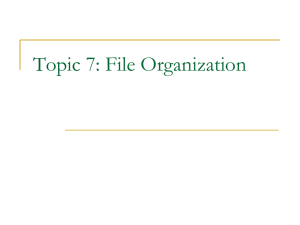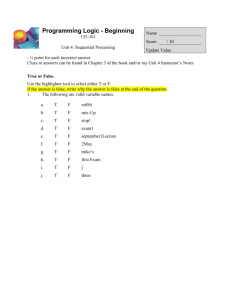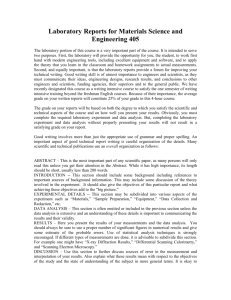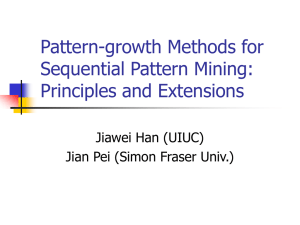Paper Title (use style: paper title)
advertisement
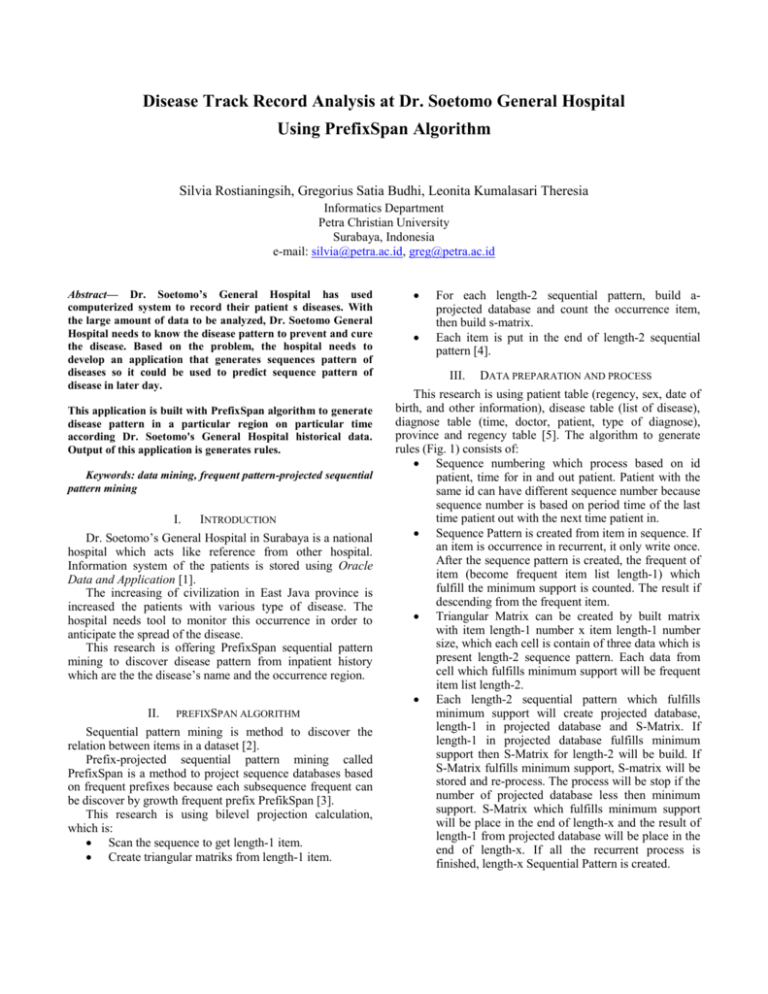
Disease Track Record Analysis at Dr. Soetomo General Hospital Using PrefixSpan Algorithm Silvia Rostianingsih, Gregorius Satia Budhi, Leonita Kumalasari Theresia Informatics Department Petra Christian University Surabaya, Indonesia e-mail: silvia@petra.ac.id, greg@petra.ac.id Abstract— Dr. Soetomo’s General Hospital has used computerized system to record their patient s diseases. With the large amount of data to be analyzed, Dr. Soetomo General Hospital needs to know the disease pattern to prevent and cure the disease. Based on the problem, the hospital needs to develop an application that generates sequences pattern of diseases so it could be used to predict sequence pattern of disease in later day. This application is built with PrefixSpan algorithm to generate disease pattern in a particular region on particular time according Dr. Soetomo's General Hospital historical data. Output of this application is generates rules. Keywords: data mining, frequent pattern-projected sequential pattern mining I. INTRODUCTION Dr. Soetomo’s General Hospital in Surabaya is a national hospital which acts like reference from other hospital. Information system of the patients is stored using Oracle Data and Application [1]. The increasing of civilization in East Java province is increased the patients with various type of disease. The hospital needs tool to monitor this occurrence in order to anticipate the spread of the disease. This research is offering PrefixSpan sequential pattern mining to discover disease pattern from inpatient history which are the the disease’s name and the occurrence region. II. PREFIXSPAN ALGORITHM Sequential pattern mining is method to discover the relation between items in a dataset [2]. Prefix-projected sequential pattern mining called PrefixSpan is a method to project sequence databases based on frequent prefixes because each subsequence frequent can be discover by growth frequent prefix PrefikSpan [3]. This research is using bilevel projection calculation, which is: Scan the sequence to get length-1 item. Create triangular matriks from length-1 item. For each length-2 sequential pattern, build aprojected database and count the occurrence item, then build s-matrix. Each item is put in the end of length-2 sequential pattern [4]. III. DATA PREPARATION AND PROCESS This research is using patient table (regency, sex, date of birth, and other information), disease table (list of disease), diagnose table (time, doctor, patient, type of diagnose), province and regency table [5]. The algorithm to generate rules (Fig. 1) consists of: Sequence numbering which process based on id patient, time for in and out patient. Patient with the same id can have different sequence number because sequence number is based on period time of the last time patient out with the next time patient in. Sequence Pattern is created from item in sequence. If an item is occurrence in recurrent, it only write once. After the sequence pattern is created, the frequent of item (become frequent item list length-1) which fulfill the minimum support is counted. The result if descending from the frequent item. Triangular Matrix can be created by built matrix with item length-1 number x item length-1 number size, which each cell is contain of three data which is present length-2 sequence pattern. Each data from cell which fulfills minimum support will be frequent item list length-2. Each length-2 sequential pattern which fulfills minimum support will create projected database, length-1 in projected database and S-Matrix. If length-1 in projected database fulfills minimum support then S-Matrix for length-2 will be build. If S-Matrix fulfills minimum support, S-matrix will be stored and re-process. The process will be stop if the number of projected database less then minimum support. S-Matrix which fulfills minimum support will be place in the end of length-x and the result of length-1 from projected database will be place in the end of length-x. If all the recurrent process is finished, length-x Sequential Pattern is created. IV. START Set Time Period, Minimum Support, Province, Multidimensional Sequence Numbering DISCOVERING SEQUENTIAL DISEASE PATTERNS TESTING Testing is using data from January 1, 2003 until December 31, 2003, with minimum support = 2, time period = 6 days, with all province (Fig. 2). Sequence and sequence pattern is built from data in Fig. 1 based on sequence number. Fig. 3 is shown frequent item list length-1 which fulfills minimum support and Fig. 4 is shown the triangular matrix. Triangular matrix which fulfills minimum support becomes length-2 sequential pattern. Create Sequence Patern and Frequent Item List Length-1 Create Triangular Matrix Generate Length-2 Sequential Pattern, Create Projected Database and S-Matriks for each Length-x Sequential Pattern END Figure 1. PrefixSpan flowchart Figure 2. Data January 1, 2003 until December 31, 2003 Figure 3. Sequence and sequence pattern (left), frequent item list length-1 (right) Figure 4. Triangular matrix (left), length-2 sequential pattern (right) Figure 5. Sequential Figure 6. Rules Fig. 5 is the result of length-x process in code form and Fig. 6 is the result with the diagnosis’s name. For example, alpha heavy chain disease is followed by psychotherapy nec. V. CONCLUSION PrefixSpan method can be used for mining sequential diseases pattern from database sequential. The generated patterns can be used a knowledge to predict sequential diseases. As a result the medical representative can take preventive and curative action more precisely. The rule will increase as the smaller minimum support, but it will cost time processing. ACKNOWLEDGMENT This research was supported by “Penelitian Hibah Bersaing” research grants 110/SP2H/PP/DP2M/IV/2009 and 326/SP2H/PP/DP2M/IV/2010 from Directorate General of Indonesian Higher Education. REFERENCES [1] [2] [3] [4] [5] Indonesia, Departemen Kesehatan, “Sistem informasi rumah sakit di Indonesia, Jakarta, 2000. Han, Jiawei, Kamber, Micheline, “Data mining : Concept and techniques”, Canada: Simon Fraser University, 2000. Han, Jiawei, et al, “Mining sequential patterns by pattern-growth : The PrefixSpan Approach”, IEEE Transactions on Knowledge and Data Engineering, ol. 16, November 2004, pp 1424-1140. Han, Jiawei, et al, “PefixSpan : Mining sequential patterns efficiently by prefix-projected pattern growth”, Proceedings of the 17th International Conference on Data Engineering, 2001, pp 215-224. Kusuma, Yinsi R., Renov Yapola, “Implementasi star schema dan data warehouse pada RSU Dr. Soetomo, unpublised literature, Petra Christian University, Surabaya, 2009.

